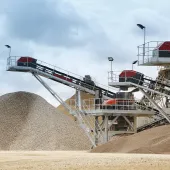MPA appointed to model carbonation of concrete

Association to model carbonation of concrete across UK buildings and infrastructure for BEIS
A Government-backed project to calculate and measure the carbon dioxide emissions that are naturally absorbed by concrete used in UK buildings and infrastructure, is set to commence.
When implemented, the UK will have the first national Greenhouse Gas Inventory in the world to include a robust scientific model (Tier 2*) to calculate the emissions sink benefit provided by the carbonation of concrete over its lifecycle.
Carbonation is a process that occurs naturally in concrete where hydrated minerals react with carbon dioxide from the air to form calcium carbonate.
The Department for Business, Energy and Industrial Strategy (BEIS) has appointed the Mineral Products Association (MPA) to head an expert consortium** to assess the size of the emissions sink for the carbonation of concrete in the UK.
The project will create a methodology which will inform the UK’s Greenhouse Gas Inventory and the UK’s national and international reporting obligations on climate change.
Buildings account for 42% of greenhouse gas (GHG) emissions either directly from heating or indirectly through electricity use. This research will determine what the concrete use in buildings and infrastructure contributes to absorbing atmospheric CO2 by improving the national GHG accountancy.
Whilst the Sixth Assessment Report from the Intergovernmental Panel on Climate Change (IPCC) recognized concrete carbonation, there is not currently an approved method for calculating the emissions sink associated with the carbonation of concrete in the United Nations Framework Convention on Climate Change (UNFCCC) 2019 Refinement. This research will help fill that gap.
Dr Richard Leese, director of industrial policy, energy and climate change at the MPA, said: ‘Delivering net-zero concrete and cement production in the UK is not reliant on carbonation. This natural carbonation has previously been overlooked by national and international carbon accounting but can undoubtedly contribute to helping the industry remove more CO2 from the atmosphere than it emits, especially when carbonation can be enhanced or accelerated.
‘By assessing exposed concrete used in buildings to bridges, this important research will help improve UK carbon accounting and provide an accurate assessment of carbonation across the lifecycle of the built environment. It could also shape how future buildings and infrastructure are designed and used, and improve the subsequent use of demolition material to act as carbon sinks and accelerate the CO2 uptake process.’
The UK concrete and cement industry has set out a roadmap to reduce emissions to beyond net zero by 2050. Net zero will be met through decarbonized electricity and transport networks, fuel switching, greater use of low-carbon cements and concretes as well as carbon capture, use or storage (CCUS) technology for cement manufacture.
Beyond net-zero emissions will be achieved by using the natural, in-use properties of concrete, which include its ability to absorb carbon dioxide during use, and the benefit of using the thermal properties of concrete in buildings and structures to reduce operational emissions.
* A tier represents the level of methodological complexity in the IPCC guidelines for national greenhouse gas inventories. Tier 1 is the basic method often using generic factors; Tier 2 – intermediate models; Tier 3 – most demanding in terms of complexity and data requirements. Tiers 2 and 3 are sometimes referred to as higher-tier methods and are generally considered to be more accurate. The Swedish Environmental Research Institute IVL has included a Tier 1 estimate in the Swedish national GHG account.
** The MPA-led consortium includes contributions from project partners at Heriot Watt University, Ricardo, and The Concrete Society.









